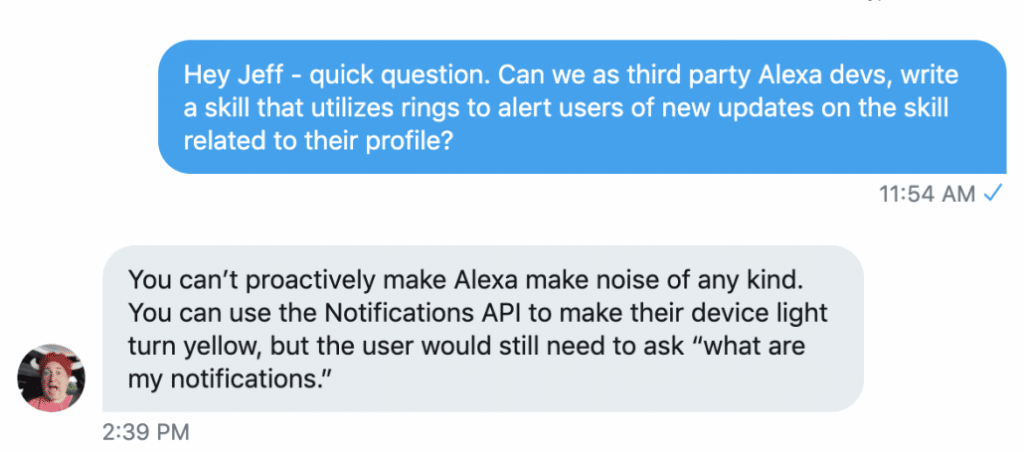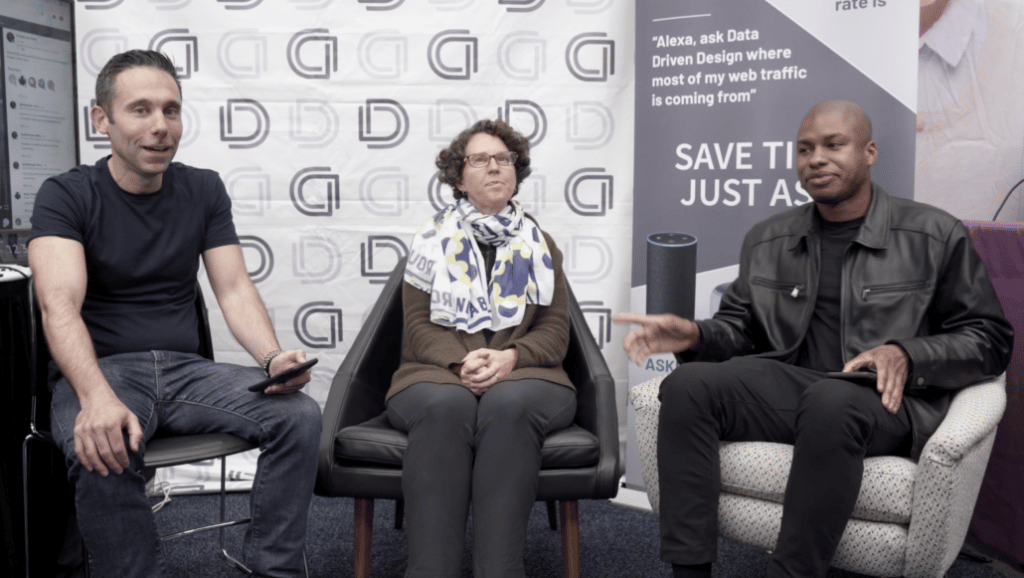Must Read: What Will Happen In Voice In 2020
READ
2020 is going to be a HUGE year for Voice. Specifically, 2020 is going to be the year that most businesses start to get entry-level Voice Apps, just like they started getting websites in the early 2000s.


SMBs Will Get A Voice
What does this mean? It means that your local HVAC repair business, dentist, barber shop or even community college will start to allow customers to ask Alexa for information about their business.
So you can be sitting on the couch, in a business meeting, jogging or in the waiting room, or driving – of course – and just ask Alexa to “launch Twice Daily convenience stores” to hear hours of operation at local stores, hear deals per store, or make sure they have your favorites.
Let’s be clear, this technological capabilities have been around for years, but 2020 will be the year that more businesses than ever actually make the investment to build their presence on top of Alexa – and Google Assistant – of course.
Why? The Data shows that Amazon Alexa Smart Speaker purchases and usage continues to dominate the smart speaker segment and growth is on the rise yet again.
While Alexa Skill Growth has plateaued, according to Voicebot.ai it’s about to rise again. Why? Because up until recently, only large brands like CNN, Disney, NPR, Nike, Coca-Cola and The Grammys, for example, have been able to invest in Voice App Experiences worthy of using. But now, with tools like TheVoiceDesigner.com, Voiceflow, Voicify and EngageByVoice.com, the lift is lower than ever for Small Businesses to build voice apps and deploy them to Alexa and Google Assistant.
These no-code required tools have become the WordPress and SquareSpace of Voice, lowering the barrier to entry and widening the opportunity for SMBs to get involved.


Businesses Will Need To Be On All Voice Assistants
If Google Chrome, Safari, Firefox and Edge are different ways of displaying websites, that no business can afford to not have their website show up on, then all voice assistants (Google Assistant, Alexa, Siri, Bixby) are all un-ignoreable.
So in 2020, the question for businesses who want to invest in a Voice App is not “which assistant should I be on?” or “which device should I be on?” but rather… “how should we build our overall suite of voice apps to be relevant and easily deployable to all assistants?
Tools like TheVoiceDesigner.com and Voiceflow already focus on taking care of giving SMBs the ability to build voice apps in one authoring tool that then deploys to both Alexa and Google Assistant.
And these platforms chose Alexa and Google Assistant with good reason. Basically, if you’re an American based business, those really the only two voice assistants being used by your consumers.
Alexa dominates in-home / on the go smart device usage, with the Echo and Echo Show devices becoming mainstays in bedrooms, family rooms and kitchens across the U.S. At Project Voice in January, Amazon Alexa Evangelist Jeff Blankenburg reiterated that a suite of new products would become widespread, including the Echo Buds, Echo Glasses, and more.
While Apple’s Siri has 375M active monthly users and Alexa has 200+ million total users and hasn’t published an “MAU” number yet, the Smart Speaker Sales numbers for Amazon Alexa dominated other competitors and rose in Q3 of 2019 in spite of competition from custom assistants from entities like Bank of America, Capital One and Mercedes. Expect the custom assistant trend to continue, but don’t worry, if you’re a business investing in an Alexa Skill, your opportunity is huge to reach your target audience and will only continue to grow.
What keeps Google Assistant relevant is that it dominates the “monthly active users” of all voice assistants at a whopping 500 million active monthly installs and more than 1 billion total installs. But keeping this in context, this number is only this large due to the fact that Google Assistant comes pre-installed on all Google Pixel phones, like Siri on iOS or Bixby on Samsung devices.
Let’s be clear, Alexa is the voice assistant of CHOICE in America and will continue to be. All businesses need to be there.
If you’re a small business, you want to be on Alexa because that’s the entire smart speaker market. You also want to be on Google Assistant due to it’s reach on smart phones.
There’s nothing you can really do on Siri right now other than shortcuts, which are not voice apps, but rather way to access/open iOS mobile apps via a simple voice command.
Samsung’s Bixby could be game changing at some point, but right now the adoption promise is really all in Asia – according to the data – so U.S. SMBs can safely table Bixby for now. Developers on the other hand, should dig in now, due to Adam Cheyer’s keynote at Project Voice.


Small Business Owners need to be on Alexa and Google Assistant for three main reasons.
1. You can only do so much with your resources
2. Authoring tools exist to build with low lift and deploy one voice app to both platforms
3. You’ll cover almost 100% of the Voice user base in the U.S. in 2020 with these two platforms.
Trends To Participate In
Just like the “mobile responsive website” and “wide hero image long scroll” and “sticky navigation” on websites, there are voice user interface trends that businesses building voice apps need to follow or even lead further in 2020. Here are my top ones in order…
1. Multimodal Experiences – what the heck does this mean? A Multimodal voice app means it’s designed to deliver an excellent experience whether accessed on a device with a screen or not. Alexa has APL (Alexa Presentation Language) which you can see on display literally if you ask your Echo Show, Echo Show 5 or Fire TV App to “… launch AllRecipes” “…launch Food Network” or “…launch Carmen Johnston Gardens.”
A true multimodal voice app allows the user to invoke the skill via voice, see very visually pleasing design and imagery on the screen while hearing solid voice navigation choices, and allowing the user to touch/tap the screen to navigate further, or continue to navigate via voice.
These skills also allow for video to be played via custom intents. “Alexa, show me how to make a Jack-o-lantern,” for example.
Notice I said “skill” through this whole paragraph. That’s because Google Actions doesn’t allow for video to be played in an Action, nor does it have a friendly authoring tool for VUI/VUX designers to build in. So the apps that developers can build are limited on Google Assistant as opposed to Amazon Alexa.
Sales of the Show and Show 5 continue to climb, so if your skill doesn’t account for screens in 2020, you’ll fall behind.
At the same time, your skill should also provide value to people who may only be on the Echo buds.
2. Replacing the robot voice – This is fairly simple to do currently, and I’m NOT talking about changing your hardware device to have Samuel L. Jackson say stuff. I’m talking about the software voice app your business builds for your users/customers to invoke having YOUR voice, or one of your employees or real customers’ voices, or the voice of a voice actor that you hire. ESPN built an “ask Matthew Berry” skill for fantasy football advice, and Data Driven Design built “Ask Carmen Johnston Gardens.” Berry’s voice is featured instead of the robot voice, and Carmen’s is featured instead of the robot voice, and the user experience is WAY BETTER and more engaging.
3. Getting found on Alexa (let’s call it “SAO” – Search Alexa Optimization) – At Project Voice, I asked Amazon Alexa’s Jeff Blankenburg how businesses can get found on Alexa. While waking Alexa with a phrase like “Alexa, how do I make a Jack-o-lantern” I’ve noticed more frequently over the last 6 months that if Alexa doesn’t have an answer, it will suggest Skills that do. So if we build “How to build a Jack-o-lantern” into our Carmen Johnston Gardens Skill, for example, along with hundreds of other Home, Garden, Recipe and how-to tips - users may not actually need to say “Alexa, Launch Carmen Johnston Gardens” to find that content. Alexa should start to say “I have a skill that you could try…” after the user simply says “…. How to make a Jack-o-lantern.”
I confirmed with Blankenburg that nobody really knows how this formula works, but he says the more content, and the better description and keywords in the Alexa Skills Kit console, the more likely your skill is to be recommended as a result for these “voice assistant searches.”
Blankenburg confirmed that partnerships are not paid currently, so any business with a skill can show.
GET. IN. NOW!
4. Whitelabeling on Google Assistant – What if I told you that there’s another chance to buy that one-or-two-word domain name you always dreamed of owning? Well, on Google Assistant right now, you can go into the Google Actions Console and reserve your invocation (aka, your voice-domain name). You can bet I’ve already started for myself, Data Driven Design and our clients. 2020 will be the year that this becomes commonplace.
This is significant because right now on Google Assistant, only one Action can have an invocation, but on Alexa, many Skills can have the same one.
This could change, but for now, you should go to the Google Actions Console and get yours for free so nobody else does.
5. Amazon Pay Integration and Account Linking – The data shows users want the frictionless experience of adding products to their Amazon cart via voice command. Since every Alexa enabled device is linked to an Amazon account, it is relatively low lift for developers like us to add Amazon Pay integration to Alexa Skills. Without Account Linking, the user can add products to their cart via voice, and Skills can prompt them to add specific products while within a Skill experience. But the user still has to confirm checkout on their device.
With Account Linking, however – (a feature that links a user’s Amazon, and thus Alexa, profile to a specific Skill), a user can have a full account history, save favorites and actually purchase / reorder products and services directly from within the Skill.
6. Alexa For Business Private Skills – My personal favorite for businesses. Think voice-based company intranets, trainings, etc. only accessible to employees of your organization. Alexa For Business Private Skills may end up being the single biggest game changer for company efficiency and production over the next 1-3 years.
Questions for Amazon:
7. Can developers use Alexa Voice Service to add Alexa “in-app”?
8. Can developers add “colored ring alerts” on Alexa enabled devices for Skills to notify users of new content? (like iOS/Android push notifications or new messages in your voice app’s email inbox). We’ve seen this done, but mostly by Amazon. There has to be a way developers can build this feature in their voice apps. I can think of a dozen reasons/use cases for this.
And my guy @jeffblankenberg already answered this one!

Thanks Jeff!

Questions for Google:
9. Why don’t you allow video?
10. Why don’t multiple invocations work? (Let’s Talk… is the only one that works in the Actions Console).
If you’re intrigued but intimated, please contact me. I promise we can make all of this easy and low lift for your business to implement and gain efficiency and effectiveness via voice in 2020.
Attention business owners: Voice is not “another thing you have to do.” Voice should help you do all the things you’re already trying to do.

Thanks for reading, watching and listening, and have a great day!
KEEP MARKETING!
Paul Hickey, Founder / CEO / Lead Strategist at Data Driven Design, LLC and founder of Nashville Voice Conference, has created and grown businesses via digital strategy and internet marketing for more than 15 years. His sweet spot is using analytics to design and build websites and grow the audience and revenue of businesses via SEO/Blogging, Google Adwords, Bing Ads, Facebook and Instagram Ads, Social Media Content Marketing, Email Marketing and most recently, Voice App Design and Development - Alexa Skills and Google Actions. The part that he’s most passionate about is quantifying next marketing actions based on real data.
